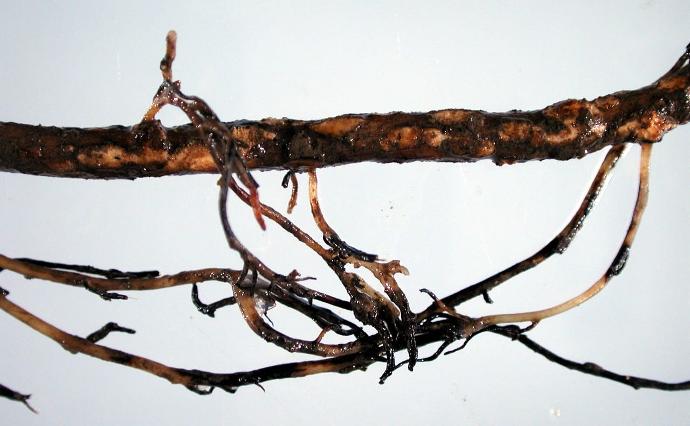Hardy Kiwi
Hardy kiwi vines, 10-15 feet tall in Zones 4-8, grow rapidly and prefer well-drained soil in full sun to partial shade. Known for their smaller and edible kiwis, hardy kiwis are a unique addition to gardens.
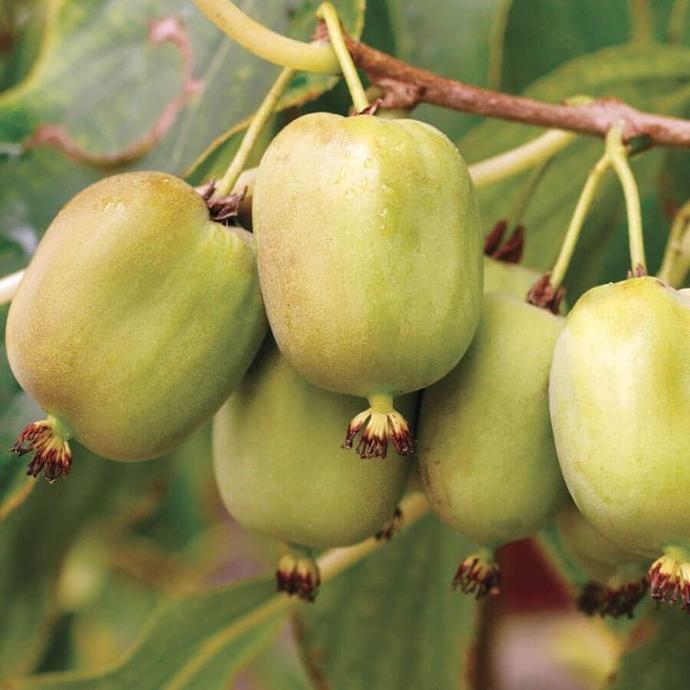
Habit
Vine
Height
10-20 ft
Growth
Fast
Soil
Well-drained, loam
Shade
Full Sun to partial shade
Moisture
Moderate
Edible
Yes
Medicinal
Yes
Origin
Asia
Climatic Condition
Temperate
Temperature (°)
5-25°C
Humidity (%)
50-80
Potting media
Loam, compost
Fertilizers
Organic
Watering
Regular
Plant Weight
20-50 g
Flowering Time
Spring
Soil Ph level
5.5-7.0
Water Ph level
6.0-7.5
Soil EC
1.0-1.3
Yield Per Plant
10-50 kg/vine
NPK ratio
10:10:10
life Span
50+ years
Health Benefits
Rich in vitamin C, edible fruit
Suggested Grow Media or Potting Mix ?
50% loam, 25% compost, 25% sand
Suggested Fertigation/Fertilizers
Fertilize every 6 weeks with a balanced fertilizer.
Common Diseases and Remedies
`Root rot , Bacterial leaf spot .
Red brown dis colouration of roots and root crowns which is visible when root is cut into two , Brown colour spots observed and leakage of red rusty gum .
Trichoderma viridae @ 4 / Lt of water , Pseudomonas flourescence @ 10 gr/Lt of water
HEALTH BENEFITS
· Rich in vitamin C, fiber, and antioxidants.
· Supports digestion, immune function, and heart health.
· May help regulate blood sugar levels.
What Is A Hardy Kiwi ?
The cold-hardy kiwi plant, also known as the kiwi plant, is a small, cold-hardy relative of many kiwi species (gourmet kiwi). It produces small fruits that taste like regular kiwis but have a hard skin. Cold-hardy kiwi plants are native to Southeast Asia and are valued for their ability to withstand colder weather than kiwifruit.
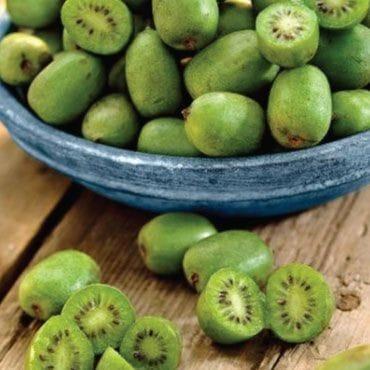
What Are The Different Types Of Hardy kiwi?
1. Issai:-
Issai is a self-pollinating variety of hardy kiwi, meaning it does not need other plants for pollination. It produces small, sweet berries and is known for its growing habit, making it suitable for small gardens or containers.
2. Anna:-
Anna is another self-pollinating variety that produces medium-sized fruits with a sweet-sour flavor. It is valuable due to its high productivity and resistance to diseases.
3. Ken's Liab:-
Ken's Liab is known for its pink-red leaves, making it a beautiful ornamental plant as well as fruit. It produces small to medium-sized fruits with a sweet taste.
4. Meader:-
Meader is a hardy, productive variety that produces small to medium-sized fruits with a sweet taste. It is appreciated for its reliable results and cool operation.
5. Weiki-
Weiki is a variety that produces small, oval-shaped fruits with a sweet-sweet taste. It is valuable due to its high productivity and resistance to diseases.

How To Care For Hardy Kiwi ?
Caring for hardy kiwi trees requires proper growth, proper pruning and regular maintenance.
1.Location:
Hardy kiwi plants thrive in full sun, well-drained soil and protection from strong winds. Choose a sunny or partially shaded location, preferably with at least 6-8 hours of sunlight per day. Adequate sunlight ensures good growth and fruit production.
2.sunlight:
Hardy kiwi plants prefer full sun locations to partial shade. This usually means they need at least 6-8 hours of direct sunlight per day. Adequate sunlight is essential for photosynthesis, which supports plant growth and fruit production. Exposure to sunlight is important for the growth and ripening of kiwi fruit. Fruits exposed to sunlight may have better taste, color and sweet content. Although hardy kiwi plants grow in full sun, they can tolerate partial shade, especially in hot weather. But too much shade can reduce fruit yield and overall hardiness.
3.Soil:
Hardy kiwi plants prefer well-drained soil to prevent stagnant water that can cause root rot and other problems. Do not use heavy clay that retains water for a long time. Sandy loam or loam soils are the best soils because they provide good drainage while retaining water and nutrients. Choose a location with fertile soil rich in organic matter. Adding compost or well-rotted manure to the planting area before planting will help improve the fertility and structure of the soil. Fertile soil provides the necessary nutrients for good growth and more fruit.
4.Hydration:
Proper irrigation is critical to the health and productivity of hardy kiwifruit trees. Hardy kiwi plants prefer soil that is regularly moist but not waterlogged. Water deeply and regularly, especially during fruit growth and development. Make sure the soil is evenly moist but do not stand in water as this can cause root rot. When watering hardy kiwi plants, make sure the water penetrates the soil to deepen root development. Shallow watering makes the base shallow, making plants more susceptible to stress.
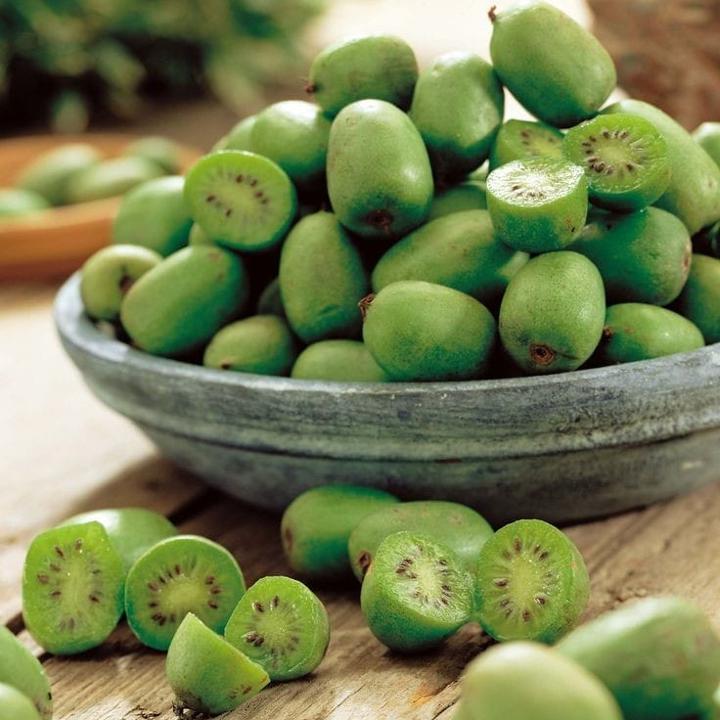
5.Nourishment:
Hardy kiwi plants benefit from regular fertilization to ensure they have adequate nutrients for growth and fruit production. Use a balanced fertilizer or one specifically designed for fruit. Add organic matter, such as compost or well-rotted manure, to the soil before planting hardy kiwi vines. Organic matter also enriches the soil, improves its structure and provides plants with essential nutrients. In addition to essential nutrients such as nitrogen, phosphorus and potassium, hardy kiwifruit plants can benefit from additional micronutrients such as magnesium, calcium and iron. Conduct soil testing to determine nutrient levels and make necessary adjustments to micronutrient fertilizer plants.
6.Issues:
Kiwi plants adapted to cold may face many problems such as pests, diseases and environmental stress. Hardy kiwi plants can be affected by pests such as aphids, spider mites, scale insects and Japanese beetles. These insects feed on leaves, sap or fruit, causing damage and possibly reducing plant vigor and fruit production. Diseases affecting hardy kiwifruit plants include powdery mildew, canker disease and root rot. Powdery mildew appears as a white, powdery coating on leaves and stems, while the fungal infection causes cankers, wilt and death. Root rot is usually caused by overwatering or poor soil quality, causing root rot and plant loss.
What are the benefits of kiwi plant's?
Unlike the hairy skin of the regular kiwifruit (which is usually peeled before eating), the fruit of the hardy kiwifruit plant has a smooth, edible skin. This makes them easier to eat because the entire fruit can be eaten without peeling. The hardy kiwi fruit is rich in vitamin C, vitamin K, fiber and other important nutrients. They offer healthy and nutritious snacks for those who want to increase their fruit consumption. The hardy kiwi plant is known for its growth and high capacity. With proper care and maintenance, they can produce large harvests of fruit every year. Some durable kiwi plants have ornamental value as well as their fruit-bearing properties. Varieties with colorful leaves or beautiful flowers can enhance the beauty of your garden or landscape.
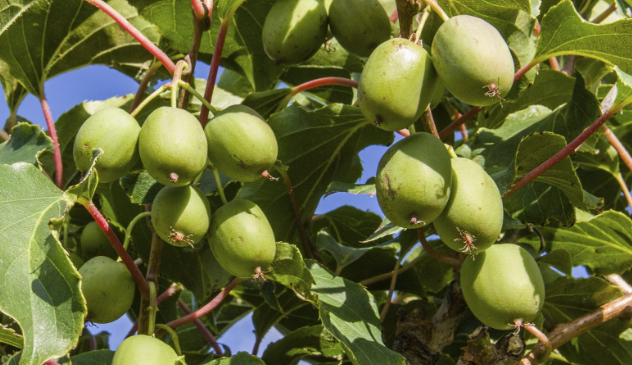
FAQ’s about growing hardy kiwi plants
1.What are the best growing conditions for kiwifruit plants?
Hardy kiwi plants thrive in full sun to partial shade and receive at least 6-8 hours of direct sunlight per day. They like good soil, fertile, slightly acidic soil with a pH between 6.0 and 6.5. Sandy loam or loam soil is ideal. Provide plants with regular water and ensure the soil is moist but not waterlogged. Deep watering is recommended to stimulate root growth. Cold-hardy kiwi plants are hardy and tolerate heat in USDA hardiness zones 4-8. They need a cold period to break their winter dormancy and start bearing fruit. plant in a place that can withstand cold wind, which can damage and affect the fruit. Leave enough room for the vines to stretch and climb. Space them at least 10 feet apart to provide adequate growing space and air circulation.
2. How to propagate hardy kiwi plants?
1. Softwood Cuttings
2. Hardwood Cuttings
3.What are the benefits of kiwi plant's?
The hardy kiwi fruit is rich in vitamin C, vitamin K, fiber and other important nutrients. They offer healthy and nutritious snacks for those who want to increase their fruit consumption. The hardy kiwi plant is known for its growth and high capacity. With proper care and maintenance, they can produce large harvests of fruit every year.
4. How to care for hardy kiwi plants in winter?
Continue watering the hardy kiwi plant regularly until the soil freezes, especially if rain is not sufficient. Plants with better water can withstand cold and winter stress. Prune cold-hardy kiwi plants in late winter or early spring while they are still dormant. Remove any dead, damaged or diseased trees, as well as any excess growth that may have occurred during the previous growing season. Pruning helps maintain a balanced structure, encourages air circulation and encourages fruit production.
5. Can hardy kiwi plants be planted in containers? If so, what are your tips for planting?
Choose a large container with a capacity of at least 20-30 gallons to accommodate the growth of hardy kiwi trees. Larger containers provide adequate room for root growth and reduce the need for repotting. make sure there is enough water at the bottom of the box to prevent waterlogging. Use a well-drained potting mix specially formulated for container gardening to encourage root growth. Provide a stable support structure, such as a trellis, pergola, or obelisk, for the vines to climb and stretch. Container support structure that secures the container to prevent the plant from tilting or becoming unstable as it grows.
